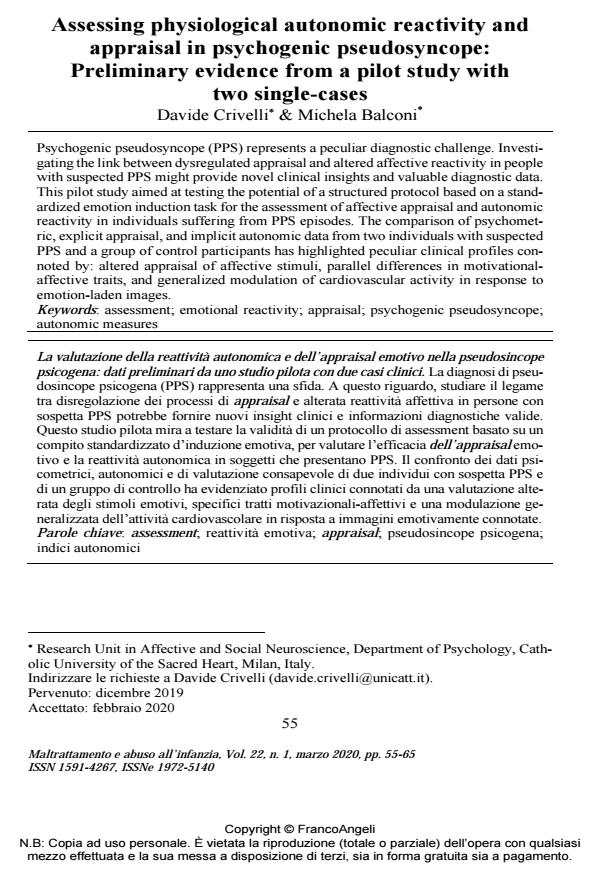Assessing physiological autonomic reactivity and appraisal in psychogenic pseudosyncope: Preliminary evidence from a pilot study with two single-cases
Titolo Rivista MALTRATTAMENTO E ABUSO ALL’INFANZIA
Autori/Curatori Davide Crivelli, Michela Balconi
Anno di pubblicazione 2020 Fascicolo 2020/1
Lingua Inglese Numero pagine 11 P. 55-65 Dimensione file 183 KB
DOI 10.3280/MAL2020-001005
Il DOI è il codice a barre della proprietà intellettuale: per saperne di più
clicca qui
Qui sotto puoi vedere in anteprima la prima pagina di questo articolo.
Se questo articolo ti interessa, lo puoi acquistare (e scaricare in formato pdf) seguendo le facili indicazioni per acquistare il download credit. Acquista Download Credits per scaricare questo Articolo in formato PDF

FrancoAngeli è membro della Publishers International Linking Association, Inc (PILA)associazione indipendente e non profit per facilitare (attraverso i servizi tecnologici implementati da CrossRef.org) l’accesso degli studiosi ai contenuti digitali nelle pubblicazioni professionali e scientifiche
Psychogenic pseudosyncope (PPS) represents a peculiar diagnostic challenge. Investigating the link between dysregulated appraisal and altered affective reactivity in people with suspected PPS might provide novel clinical insights and valuable diagnostic data. This pilot study aimed at testing the potential of a structured protocol based on a standardized emotion induction task for the assessment of affective appraisal and autonomic reactivity in individuals suffering from PPS episodes. The comparison of psychometric, explicit appraisal, and implicit autonomic data from two individuals with suspected PPS and a group of control participants has highlighted peculiar clinical profiles connoted by: altered appraisal of affective stimuli, parallel differences in motivational-affective traits, and generalized modulation of cardiovascular activity in response to emotion-laden images.
La diagnosi di pseudosincope psicogena (PPS) rappresenta una sfida. A questo riguar-do, studiare il legame tra disregolazione dei processi di appraisal e alterata reattività affettiva in persone con sospetta PPS potrebbe fornire nuovi insight clinici e informa-zioni diagnostiche valide. Questo studio pilota mira a testare la validità di un protocollo di assessment basato su un compito standardizzato d’induzione emotiva, per valutare l’efficacia dell’appraisal emotivo e la reattività autonomica in soggetti che presentano PPS. Il confronto dei dati psicometrici, autonomici e di valutazione consapevole di due individui con sospetta PPS e di un gruppo di controllo ha evidenziato profili clinici connotati da una valutazione alterata degli stimoli emotivi, specifici tratti motivazionali-affettivi e una modulazione generalizzata dell’attività cardiovascolare in risposta a im-magini emotivamente connotate.
Parole chiave:Assessment; reattività emotiva; appraisal; pseudosincope psicogena; indici autonomici
- Neurofeedback as neuroempowerment technique for affective regulation and interoceptive awareness in adolescence: preliminary considerations applied to a psychogenic pseudosyncope case Michela Balconi, Laura Angioletti, Davide Crivelli, in Frontiers in Rehabilitation Sciences 1056972/2023
DOI: 10.3389/fresc.2023.1056972 - Electrophysiological signature of interoceptive attention: a spectral and source localization analysis Davide Crivelli, Michela Balconi, in Cognitive, Affective, & Behavioral Neuroscience /2025 pp.402
DOI: 10.3758/s13415-024-01235-3
Davide Crivelli, Michela Balconi, Assessing physiological autonomic reactivity and appraisal in psychogenic pseudosyncope: Preliminary evidence from a pilot study with two single-cases in "MALTRATTAMENTO E ABUSO ALL’INFANZIA" 1/2020, pp 55-65, DOI: 10.3280/MAL2020-001005